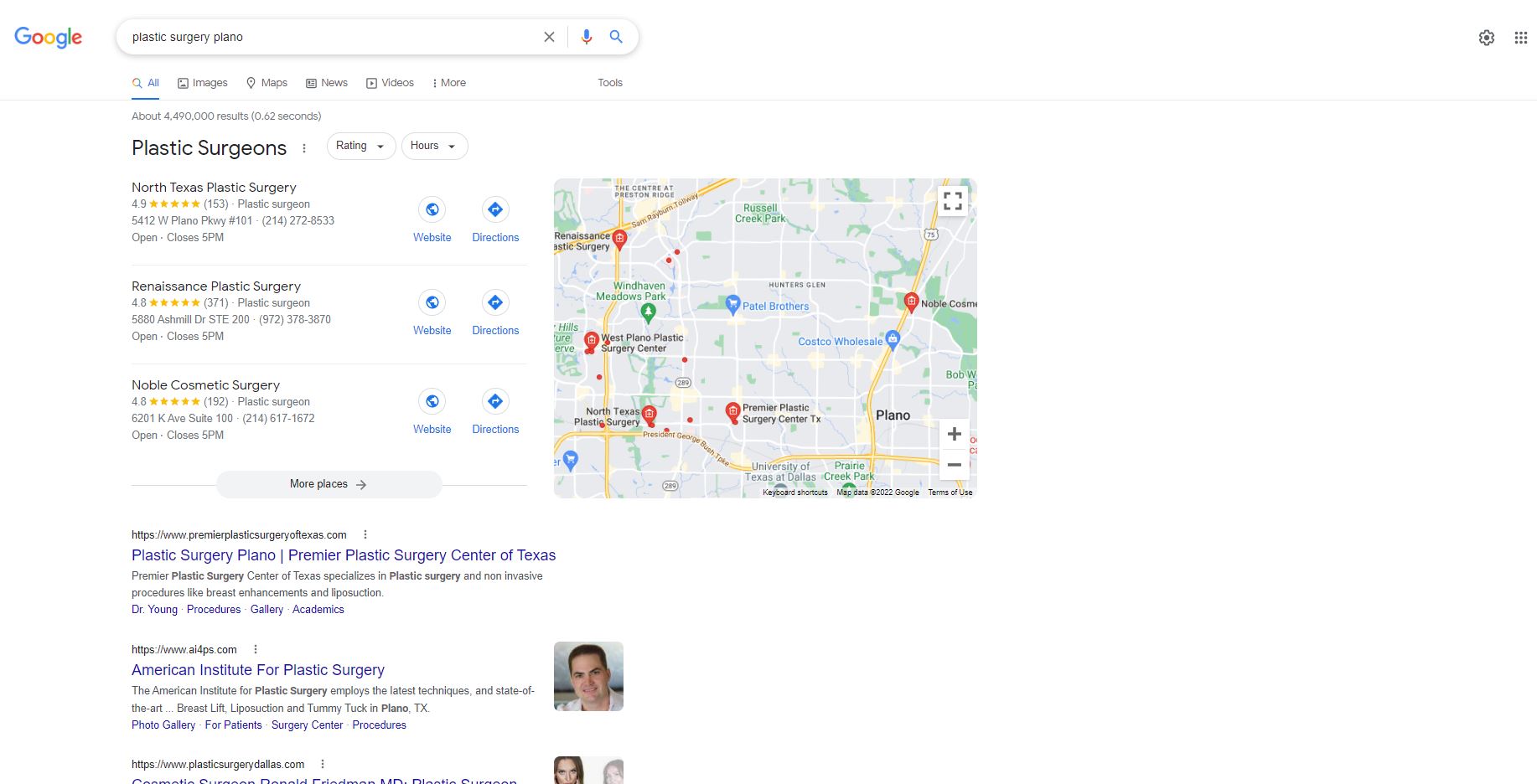According to the American Academy of Facial Plastic and Reconstructive Surgery, in 2021, the number of performed plastic surgeries increased by 40%. In 2022, the numbers continue to rise.
To take full advantage of the surging demand, clinics need to pay more attention to local SEO. While traditional SEO for plastic surgeons can help with lead generation, local SEO has additional advantages.
What is SEO for Cosmetic Surgeons?
Cosmetic Surgeon SEO involves optimizing a website to rank higher in search engine results for terms related to cosmetic surgery. This specialized form of SEO enhances online visibility, attracts potential patients, and increases conversions by targeting those actively searching for cosmetic procedures.
Why is Local SEO Important for Plastic Surgeons?

Local SEO is a marketing strategy that focuses on attracting, converting, and retaining a local audience. While traditional SEO works on bringing your website to the top of the SERPs (Search Engine Result Pages), local SEO also puts your practice in front of the local searchers.
With local SEO, you are aiming your organic marketing strategy at demonstrating your website on the search results in response to location-related queries. Meanwhile, traditional SEO optimizes your website to capture a global audience.
Local SEO is an integral part of a successful digital marketing strategy for practices that serve a specific area. Here are a few reasons why it deserves your attention.
Online Searches Start with Google
Around 7% of all Google queries are health-related. Overall, Google is an important tool for patients researching cosmetic procedures and trying to find the best surgeon for their needs.
Whether a potential patient is researching reconstructive procedures or looking for a cosmetic surgeon, their first point of contact is Google. If your practice shows up on top of the page in response to their query, they are highly likely to visit your website.
Once they click the link and enter your website, your conversion tactics kick in. Even if their search was purely informational, they will remember your clinic as an authoritative source of information. When the time comes, these patients are likely to schedule an appointment.
Local SEO Attracts Local Prospects
Local SEO works to bring local patients to your website. If your clinic pops up in response to a general search, such as “Facelift pros and cons,” you could get people from all over the world to visit your website.
Their conversion potential is low because the majority of people aren’t likely to drive for more than 30 minutes for a plastic surgery appointment if another clinic is closer. When you implement local SEO tactics, you target local visitors, who are much more likely to become your patients.
Local SEO Makes It Easier to Gain Visibility
While highly effective, organic SEO is a slow process. When you use traditional SEO tactics, it could take months to rank for keywords on Google SERPs.
The competition for local patients is much less fierce than for national website visitors. That’s why local SEO tactics help you gain visibility on Google much faster. The results could take weeks instead of months.
6 Essential Local SEO Tactics for Plastic Surgeons
These tactics can help you set up a successful strategy to make the most out of local SEO for plastic surgery procedures.
1. Create or Claim Your Google Business Profile
Google Business Profile (GBP) is a versatile tool that helps make your practice visible across Google services. By creating this profile, you are:
- Helping patients find your local practice.
- Soliciting reviews
- Gaining an opportunity to appear on the Google 3-pack (top 3 local search results that Google finds highly relevant to the search query)
Once you create or claim your GBP, you need to:
- Add relevant information about your practice, including necessary NAP (name, address, phone number) details.
- Select relevant categories for your practice (plastic surgeon, plastic surgery clinic).
- Provide a complete list of services no matter how minor or obvious they may seem.
- Answer common questions in the Q&A section
- Add the “book an appointment” button”
For your GBP to generate SEO results, it’s imperative to keep all the information up to date and reply to reviews as soon as they appear.
2. Conduct Keyword Research for Local SEO
Keyword research is the power behind your local SEO strategy. It differs for local and global SEO. When you make a medical keyword list for local SEO purposes, you need to focus on the searcher’s intent (the reason why someone conducts a search) and location-specific extensions.
Google recognizes the searcher’s intent and lists websites according to what the user wants. For example, if a potential patient in Boston types “breast augmentation near me,” the keyword Google responds to is “Breast augmentation in Boston.”
Plastic surgery clinics can consider three types of local keywords:
- Procedure – breast reconstruction, liposuction, eyelid surgery
- Specialty – cosmetic surgeon, plastic surgeon, reconstructive surgeon
- Location – Boston, New York, Los Angeles
To design an effective local long-tail keyword, you need to match a procedure or specialty keyword with a location keyword. For example, “hand surgery Boston” or “cosmetic surgeon New York.”
If you aren’t working with a marketing agency for plastic surgeons and need to perform keyword research on your own, you can use such free services as Google Keyword Planner. Meanwhile, many paid keyword generators, such as SEMrush and AHREFS offer free trials.
3. Work on Website Design for Local SEO
Website design is highly important for the success of your local SEO campaign. You need to pay special attention to the following elements.
NAP Consistency
All practice details such as your name, address, and phone numbers (NAP) have to be consistent across your website, GBP, and other directories. Otherwise, you risk confusing visitors and losing their trust.
Mapping Intents to Pages
When creating a page, focus on the searcher’s intent instead of specific keywords. For example, if you want to rank for “Los Angeles rhinoplasty,” you should have a page dedicated to rhinoplasty. This page should contain location-related signals (such as NAP) to show the visitor that your practice is in Los Angeles.
This approach can work side by side with implementing such keywords as “Rhinoplasty in Los Angeles.”
On-Page SEO
On-Page SEO involves implementing local keywords into different page elements, including content, meta descriptions, title tags, headers, image alt text, and more. You also need to work on structured markup to help Google index your pages accurately.
4. Build and Manage Citations
Citations are mentions of your website’s NAP on other websites. They are a ranking factor that helps bring your website to the top of the SERPs. Meanwhile, they increase your practice’s visibility and generate reviews.
Consider the following type of citations for plastic surgeons:
- Data aggregators: Factual, Localeze, Yellow Pages
- Consumer directories: Yelp, Angie’s List, Yellow Pages
- Industry directories: American Society of Plastic Surgeons, Healthgrades, The Aesthetic Society, American Academy of Cosmetic Surgery.
- Local business directories: local plastic surgery societies, local BBB (Better Business Bureau)
Similar to GBP, it’s important to maintain NAP consistency across all directories and reply to reviews whenever possible. Keep in mind that a couple of high-quality citations is much better than a hundred low-quality citations.
5. Gain Inbound Links Through Content Marketing
Inbound links or backlinks are highly important to both local and traditional SEO. Just like citations, they are mentions of your website on other authoritative sites. However, citations may not have a URL pointing back to your site.
Since backlinks are a ranking factor, they directly affect your website’s position on the SERPs. For successful link building, you need to create valuable content, which is worthy of being linked to. For example, high-quality blogs could generate links from trustworthy bloggers who find your information useful.
A good content marketing strategy is the key to generating backlinks. It involves studying the needs of the target audience, creating high-quality content, placing it on the right pages, and implementing relevant keywords.
6. Collect Google Reviews
More than 80% of patients use online reviews to evaluate a doctor before booking an appointment. Meanwhile, providing stellar services isn’t enough to generate reviews. By replying to reviews and reposting them on social media, you are encouraging patients to share their experiences with others. You can also collect and publish Google reviews on relevant pages of your website by using a review aggregation tool.
The Future of Local SEO for Plastic Surgeons
By taking advantage of the above strategies, you can gain a competitive advantage over plastic surgeons who don’t use local SEO. However, they aren’t sufficient to beat clinics that outsource local SEO to the experts. To outrun such competition, you need to throw something extra into the mix.
Updated on: July 10, 2024


